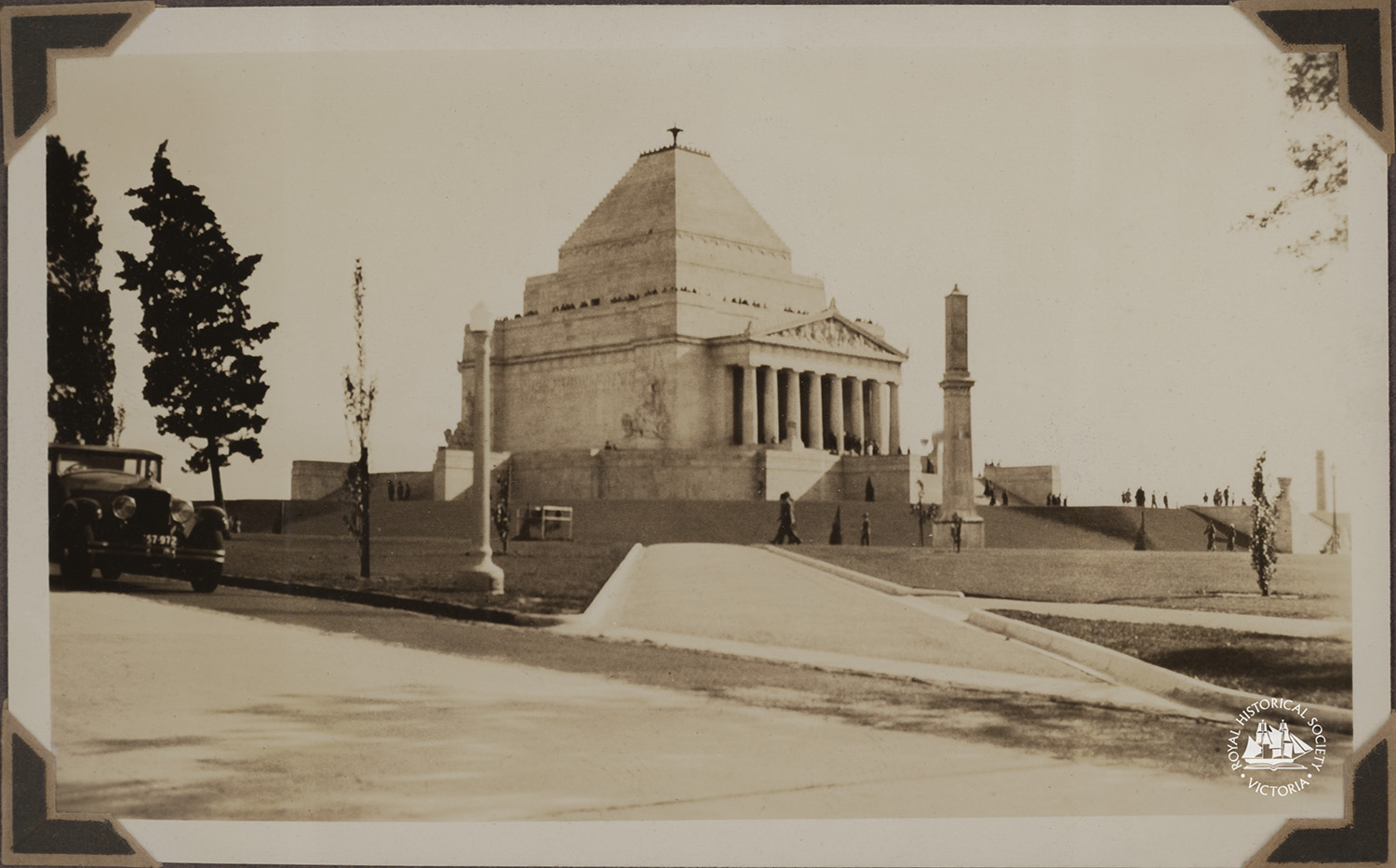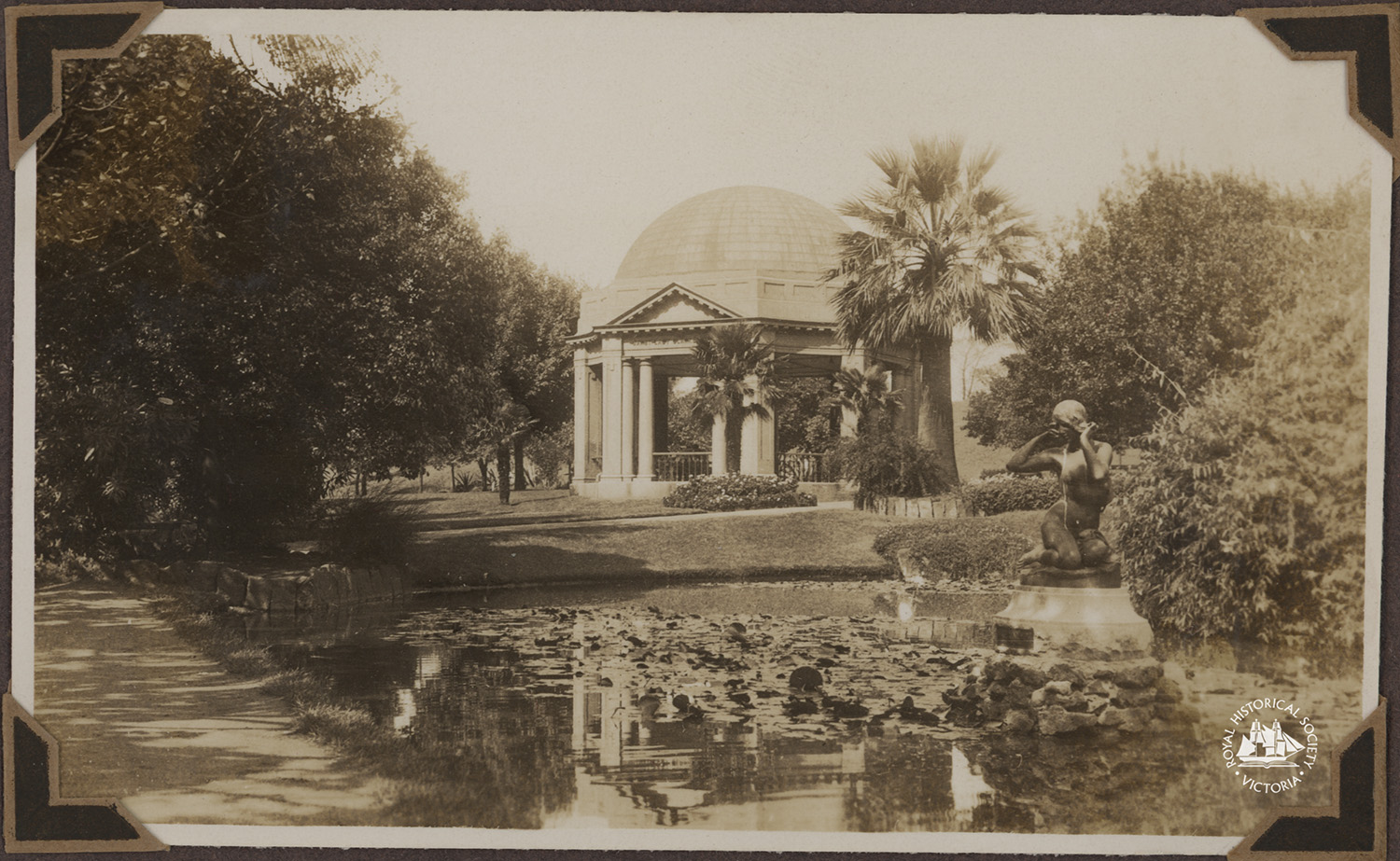Silver City and the sites of 1930s Melbourne, by Jennifer Young
A photo album can be a window to a long-passed world, full of forgotten people and lost landscapes, but a photo album can also show us what has not changed. Cityscapes full of familiar landmarks, a small sapling grown to a large tree, statues and monuments saved or moved, or a building that has survived the wasting effects of time and development to proudly stand in a world its original designers could never have imagined. These photographs from the RHSV collection show more than what has been lost, they also show us what has survived.
Library
The State Library has been a Melbourne landmark since it was first constructed in 1854 as a library, gallery and museum for the people of Victoria. As time passed and the functions of the library changed and its collection expanded the building grew, and what stands as the library today has been built and added over the 160 years of the building’s existence. The library grounds have also changed with the growing library and changing needs of the city. They were initially bounded by fences and covered with trees and shrubs, but were cleared from the 1930s onwards to create the wide lawn that is used by Melbournians today to gather, rest and protest. The statues of St Joan of Arc and St George flanking the entrance to the library have stood the test of time and weather, standing proudly as other statues have been and gone, including a pair of First World War soldiers who were moved to the Shrine of Remembrance in 1998, and this Bunyip statue which was unveiled in 2012.

The Library in the 1930s

The Library in 2022
Shrine of Remembrance
The Shrine of Remembrance is a major national and international landmark for Melbourne that was built following the First World War to commemorate the people who served and died in the war. It was officially dedicated on Remembrance Day in the Melbourne centenary year of 1934 to a population suffering through the hardships of the great Depression. Despite the Depression thousands of people visited the Shrine within its first week, and so many extra visitors were expected on Remembrance Day that a special train was run to carry all the extra passengers. While the building itself has changed little in the intervening years, it has been expanded to remember those who served in subsequent wars, and to improve accessibility. A forecourt was added to the grounds of the memorial to allow for larger crowds, but which removed the Pool of Reflection that had previously taken up much of the land to the north of the Shrine. The basement has also become a downstairs entryway and museum, with large ramparts seeming to explode from the original structure to welcome all guests to learn from and experience the Memorial.

Shrine of Remembrance Circa 1930s

Shrine of Remembrance in 2022
Lady Janet Clarke Memorial and Water Nymph
The Alexandra Gardens have grown and changed throughout the decades, illustrated by this 1925 water nymph who reclines in a lake beside a 1913 rotunda, dedicated to a woman who died in 1908. The rotunda was built as a memorial to Lady Janet Clarke, a popular and active local philanthropist who contributed to many community works during her life. She was fondly remembered after her death, and the rotunda was built using money donated to her Memorial fund. It was designed to be large enough to accommodate 100 musicians or act as a shady rest area for visitors to the Alexandra Gardens. The Water Nymph statue was purchased as a public work and unveiled in 1925 as part of a plan to add interest to the parks of Melbourne through statuary. It was intended to be the first of many statues purchased to enliven the gardens and parks of Melbourne, and was followed by a statue of Peter Pan donated to the city by Alderman Jeffries.

Rotunda and statue in the 1930s

Rotunda and statue in 2022
Peter Pan
This Australian themed Peter Pan statue, with the Boy Who Never Grew Up surrounded by Australian fauna, has lived a turbulent life since it was unveiled in 1926. It was presented to the City of Melbourne by Alderman Charles Jeffries, and was initially installed at Alexandra Gardens where it could bring joy to the children of Melbourne and add some interest to the otherwise unadorned park. The statue was later moved to the conservatory at the Fitzroy Gardens, however the humid conditions inside the conservatory did not treat the bronze statue well and it was removed from display in 1989. The statue was re-presented to the public in 1993 at its current home in the Melbourne Zoo, where it is still delighting crowds of children.

Peter Pan in Alexandra Gardens circa 1930s

Peter Pan at the Melbourne Zoo, 2022
Illuminations
From illuminated ornaments in December to light shows in the colds of Winter and any other excuse for a display, lights have been used to decorate the city since before the advent of electricity. The first big electric light display was held during the centenary of Melbourne celebrations, which were held in recognition of the first British settlements at what are now Portland and Port Phillip Bay in 1834 and 1835. Parades were held in the street, flags were raised, and the city was brightly lit each night, with temporary light posts along major streets and major buildings illuminated with special lighting. While not all cheered this excess during the Depression, it was still a time of excitement for many, with thousands of people visiting the city to see the lights and other decorations. Now the city is constantly lit with more bulbs than could have been imagined in the 1930s, lights are still used to bring joy to people during cold and difficult times.

Illuminations along Bourke Street in 1934

Lightscape at the Royal Botanic Gardens, 2022
These photos all came from a single album in the RHSV collection, a small album inscribed on the inside cover with “To dear Nell, With best wishes and fond love from, Mitta”. The identity of Nell and Mitta remain a mystery, and the journey this album took to reach our collection is an even greater mystery, one that takes us far from the borders of the Melbourne it portrays.
The album was sent to the RHSV in 1986 by Ed Jagels, from Murphy, Idaho. After some research I discovered that Ed Jagels was the owner and proprietor of the Idaho hotel in Silver City, Idaho. This hotel was erected in 1866 to serve the booming Silver and Gold Rush population of Silver City. However, just like many Victorian gold rush towns, the mines eventually went dry and the city was slowly abandoned. The hotel was closed around 1942 and fell into disrepair, alongside the other abandoned buildings of the once prosperous city, becoming just another Gold Rush Ghost Town.
However, its inevitable decay was interrupted in 1972 when Ed Jagels bought the hotel, restoring it to liveable condition, reopening it to the public, and reviving the town. Silver City currently has a small seasonal population consisting of the families working to preserve the town’s abandoned buildings, plus many tourists travelling off the beaten path to visit this small but well-preserved slice of the past. As the photo album was sent to the RHSV in 1986, it can be assumed that Ed Jagels found it among the other relics of the past left behind in the Idaho Hotel, possibly left by Nell as she stayed in this town so far from Melbourne. Unfortunately, Mr Jagels passed away in 2001 so we will never be able to learn the full story behind the discovery of this album, but we can still look at the photos it contains and remember that the past is not dead, and when treated with care can be treasured in the present and into future.
References:
Library
The history of our building | State Library Victoria (slv.vic.gov.au)
Shrine of Remembrance
History of the Shrine | Shrine of Remembrance (shrine.org.au/)
https://trove.nla.gov.au/newspaper/article/243080616
https://trove.nla.gov.au/newspaper/article/176811954
10 Nov 1934 – DEDICATION OF SHRINE. – Trove (nla.gov.au)
Memorial and Nymph
Janet Lady Clarke Memorial Sculpture – City Collection (melbourne.vic.gov.au)
31 Jul 1925 – THE WATER NYMPH – Trove (nla.gov.au)
10 Sep 1926 – STATUE FOR CITY GARDENS – Trove (nla.gov.au)
Peter Pan
Peter Pan – City Collection (melbourne.vic.gov.au)
https://trove.nla.gov.au/newspaper/article/244064941
Illumination
https://trove.nla.gov.au/newspaper/article/64285541
https://trove.nla.gov.au/newspaper/article/249477621
https://trove.nla.gov.au/newspaper/article/243065395
Silver City
Idaho Hotel (historicsilvercityidaho.com)
Exploring Idaho: Silver City, Idaho’s last real ghost town | ktvb.com

 239 A'Beckett Street Melbourne, Victoria, 3000
239 A'Beckett Street Melbourne, Victoria, 3000  03 9326 9288
03 9326 9288  office@historyvictoria.org.au
office@historyvictoria.org.au  Office & Library: Weekdays 9am-5pm
Office & Library: Weekdays 9am-5pm

